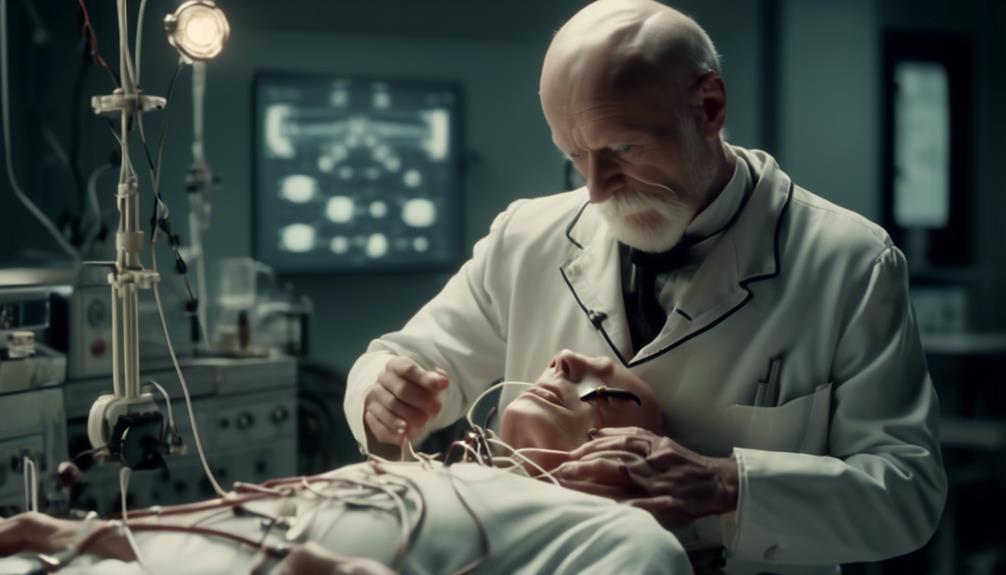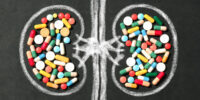Invention of the Electrocardiograph (1903) – Einthoven: Recap and Summary: Developed the First Practical ECG

The invention of the electrocardiograph by Willem Einthoven in 1903 revolutionized cardiology. It provided the first practical way to measure the electrical activity of the heart. This invention led to modern medical diagnosis and advancements in ECG technology.
Key Takeaways
- Willem Einthoven was a Dutch scientist who was born in the Dutch East Indies (now Indonesia) in 1860 and received a rigorous education, studying physiology at the University of Utrecht in the Netherlands.
- Einthoven was inspired by the electrical signals of the heart and was driven by the desire to improve cardiovascular disease diagnosis and treatment. He had a curiosity about the mysteries of the human body and believed in the potential impact of his research on patient care.
- The development process of the ECG involved meticulous design and the use of key components such as electrodes, amplifiers, and recording apparatus. This technological advancement had a profound impact on medical diagnosis, enabling the detection and diagnosis of various cardiac conditions with precision and efficiency.
- Einthoven's groundbreaking research led to the creation of a device to measure and record the heart's electrical signals, providing a deeper understanding of cardiac function and paving the way for the diagnosis and treatment of heart conditions. The ECG also opened new possibilities for the field of cardiology and revolutionized the identification and monitoring of cardiac conditions.
Early Life and Education
Einthoven's early life and education laid the foundation for his groundbreaking contributions in the field of medicine and the invention of the electrocardiograph. Born in Java, Dutch East Indies (now Indonesia) in 1860, Einthoven spent his childhood surrounded by the lush beauty of the tropical landscape. His parents, who were of Dutch descent, recognized his intellectual potential from an early age and provided him with a rigorous education.
Einthoven's early career in medicine began at the University of Utrecht in the Netherlands, where he studied physiology under the guidance of prominent scientists. He developed a keen interest in the electrical activity of the heart and conducted extensive research on the subject. His work led him to invent the string galvanometer, a device that could accurately measure and record the electrical signals produced by the heart.
This invention laid the groundwork for the development of the electrocardiograph, a machine capable of recording the electrical activity of the heart in detail. Einthoven's meticulous research and innovative thinking revolutionized the field of cardiology and opened new doors for diagnosing and understanding heart conditions.
Einthoven's childhood experiences and early career choices shaped his path towards becoming a pioneer in the field of medicine. His dedication to scientific inquiry and his relentless pursuit of knowledge set the stage for his groundbreaking achievements in the years to come.
Einthoven's Inspiration and Motivation
After establishing a strong foundation in medicine and making significant advancements in the field of cardiology through his invention of the string galvanometer, Einthoven's passion for understanding the electrical activity of the heart served as the driving force behind his inspiration and motivation. His deep-rooted curiosity about the mysteries of the human body, coupled with his desire to improve the diagnosis and treatment of cardiovascular diseases, fueled his relentless pursuit of knowledge and innovation.
Einthoven's inspiration stemmed from his realization that the heart's electrical signals held the key to unraveling its inner workings. He was intrigued by the idea that by studying these electrical impulses, he could gain valuable insights into the functioning of the heart and develop methods to detect and diagnose abnormalities. This desire to unravel the mysteries of the heart and improve patient care formed the foundation of his motivation.
Additionally, Einthoven's motivation was further fueled by his desire to contribute to the advancement of medical science. He saw the potential of his research to revolutionize the field of cardiology and believed that his work could have a profound impact on the lives of countless individuals. This sense of purpose and the potential for meaningful change propelled him forward, even in the face of challenges and setbacks.
The Development Process of the ECG
Now let's delve into the development process of the ECG.
Einthoven's groundbreaking research paved the way for the creation of this revolutionary medical device.
The key components of the ECG, such as the electrodes, amplifiers, and recording apparatus, were meticulously designed to accurately capture and analyze the electrical activity of the heart.
This technological advancement had a profound impact on medical diagnosis, enabling healthcare professionals to detect and diagnose various cardiac conditions with unprecedented precision and efficiency.
Einthoven's Groundbreaking Research
The development process of the electrocardiograph, pioneered by Einthoven, revolutionized the field of cardiology by providing a detailed and objective analysis of the heart's electrical activity.
Einthoven's contributions to the development of the electrocardiograph were of immense importance, as they laid the foundation for the modern ECG technology that we use today. Through his meticulous research and experimentation, Einthoven was able to create a device that could accurately measure and record the electrical signals produced by the heart.
This breakthrough allowed for a deeper understanding of cardiac function and paved the way for the diagnosis and treatment of various heart conditions. Einthoven's groundbreaking work not only provided valuable insights into the workings of the heart, but also opened up new possibilities for the field of cardiology, ultimately leading to improved patient care and outcomes.
Key Components of ECG
With Einthoven's groundbreaking research establishing the foundation for modern ECG technology, it is essential to delve into the key components of this innovative device and its development process. The electrocardiograph (ECG) consists of several essential components that work together to provide accurate readings of the heart's electrical activity. These components include electrodes, amplifiers, filters, and a display or recording system. Electrodes are placed on the patient's skin to detect the electrical signals from the heart. Amplifiers amplify these signals, making them easier to analyze. Filters remove unwanted noise and artifacts from the signal, ensuring accurate ECG interpretation. Finally, the display or recording system visually presents the electrical activity of the heart for clinical applications. Together, these components form the foundation of the ECG, allowing healthcare professionals to diagnose and monitor various cardiac conditions.
| Component | Function |
|---|---|
| Electrodes | Detect electrical signals from the heart |
| Amplifiers | Amplify the detected signals |
| Filters | Remove noise and artifacts from the signal |
| Display/Recording System | Visually present the electrical activity of the heart |
| Power Supply | Provides power to the ECG machine |
Impact on Medical Diagnosis
The development process of the ECG has had a significant impact on medical diagnosis, revolutionizing the way cardiac conditions are identified and monitored. Thanks to ECG advancements and technological advancements, healthcare professionals can now accurately detect and diagnose various heart-related abnormalities.
The ECG provides a non-invasive and efficient method for measuring the electrical activity of the heart, allowing doctors to assess the heart's health and function. It has become an indispensable tool in diagnosing conditions such as arrhythmias, myocardial infarctions, and heart murmurs.
The ECG's ability to provide real-time data and accurate readings has greatly improved the speed and accuracy of medical diagnoses. This hasn't only saved lives but has also allowed for more effective treatment plans and better monitoring of patients with cardiac conditions.
The ECG has truly revolutionized medical diagnosis, giving healthcare professionals the tools they need to provide optimal care for their patients.
Einthoven's Groundbreaking Discoveries
Einthoven revolutionized the field of cardiology through his groundbreaking discoveries. His contributions in advancing the electrocardiograph (ECG) technology have paved the way for significant advancements in medical diagnosis.
Here are five key discoveries that showcase Einthoven's remarkable achievements:
- Development of the string galvanometer: Einthoven invented the string galvanometer, a highly sensitive instrument that could accurately measure the electrical signals produced by the heart. This innovation was crucial in capturing precise ECG readings.
- Introduction of the standard ECG lead system: Einthoven devised a standardized lead system that enabled consistent and comparable ECG recordings. This system, known as the Einthoven Triangle, involved placing electrodes on specific locations of the body to record electrical activity from different angles.
- Identification of different ECG waves: Einthoven's meticulous observations allowed him to identify and name the P, QRS, and T waves, which represent specific electrical events during the cardiac cycle. This classification system remains the foundation for interpreting ECGs today.
- Recognition of abnormal ECG patterns: Through extensive research, Einthoven identified various abnormal ECG patterns associated with specific cardiac conditions. This breakthrough enabled doctors to diagnose heart diseases more accurately.
- Influence on medical practice: Einthoven's inventions and discoveries had a profound impact on medical practice, facilitating the widespread use of ECGs for diagnosing heart conditions and monitoring patients' cardiac health.
Einthoven's groundbreaking discoveries not only transformed the field of cardiology but also revolutionized medical diagnosis and paved the way for further advancements in understanding and treating heart diseases.
The Impact on Cardiology and Medical Diagnosis
Einthoven's groundbreaking discoveries in the field of cardiology and his advancements in electrocardiograph technology have had a profound impact on the practice of cardiology and medical diagnosis.
The invention of the electrocardiograph revolutionized healthcare by providing a non-invasive and highly accurate method for diagnosing heart conditions. Prior to Einthoven's work, physicians relied on crude methods such as listening to the patient's heartbeat with a stethoscope or palpating the pulse to detect abnormalities.
The electrocardiograph allowed for a more precise and objective assessment of the heart's electrical activity, enabling doctors to diagnose conditions like arrhythmias, myocardial infarctions, and other cardiac abnormalities with greater accuracy. This advancement in cardiology has transformed the way heart diseases are diagnosed and managed, leading to improved patient outcomes and reduced mortality rates.
Additionally, Einthoven's research paved the way for further advancements in cardiology, including the development of more sophisticated ECG machines and the integration of computer technology for data analysis.
Today, the electrocardiograph remains a fundamental tool in cardiology, playing a vital role in the early detection and treatment of cardiovascular diseases.
Recognition and Legacy of Einthoven's Work
Having revolutionized the field of cardiology and transformed the way heart diseases are diagnosed and managed, Einthoven's groundbreaking work with the electrocardiograph has left a lasting impact on the medical community. His contribution to the field of cardiology has been widely recognized, earning him numerous awards and accolades.
Here are some key points regarding the recognition and legacy of Einthoven's work:
- Nobel Prize: Einthoven was awarded the Nobel Prize in Physiology or Medicine in 1924 for his development of the electrocardiograph. This prestigious award solidified his place in medical history and highlighted the significance of his contribution.
- International Recognition: Einthoven's work with the electrocardiograph gained international attention and acclaim. Medical professionals from around the world recognized the immense value of his invention and its potential to revolutionize the diagnosis and treatment of heart diseases.
- Legacy in Cardiology: Einthoven's invention paved the way for advancements in the field of cardiology. His electrocardiograph became the standard tool for diagnosing and monitoring heart conditions, laying the foundation for future research and innovation.
- Continued Influence: Even to this day, Einthoven's work continues to shape the field of cardiology. His pioneering efforts have inspired generations of researchers and medical professionals to explore new techniques and technologies for studying the heart.
- Enduring Impact: Einthoven's contribution to the medical field can't be overstated. His invention of the electrocardiograph has saved countless lives and improved the quality of care for individuals with heart diseases, leaving a lasting legacy that continues to benefit patients worldwide.
Evolution of ECG Technology
The evolution of ECG technology has been marked by significant advancements in the diagnosis and monitoring of heart conditions. Over the years, there have been remarkable developments in the field, leading to more accurate and efficient methods of detecting cardiac abnormalities.
One of the major advancements in ECG technology is the introduction of digital electrocardiographs. These devices have revolutionized the way ECGs are recorded and analyzed. Digital electrocardiographs provide higher resolution and greater signal fidelity, resulting in improved diagnostic accuracy. They also offer features such as automatic interpretation algorithms, which aid healthcare professionals in quickly identifying abnormalities in ECG tracings.
Another significant advancement in ECG technology is the advent of wireless monitoring systems. These systems allow for continuous monitoring of patients' heart rhythms, enabling early detection and intervention in case of any cardiac events.
Furthermore, advancements in data analysis techniques and machine learning algorithms have led to the development of predictive models that can identify patterns and trends in ECG data, aiding in the early detection of heart diseases.
Future Applications and Advancements in ECG
With the continuous advancements in ECG technology, the future holds promising applications and advancements that will further enhance the diagnosis and monitoring of heart conditions. Here are some potential uses and future advancements in ECG:
- Remote Monitoring: ECG devices can be integrated into wearable technology, allowing individuals to monitor their heart health in real-time and receive alerts for any irregularities. This remote monitoring capability can provide freedom and peace of mind, especially for those with chronic heart conditions.
- Artificial Intelligence (AI) Integration: AI algorithms can analyze ECG data to detect patterns and abnormalities that may be missed by human interpretation. This integration can improve accuracy and efficiency in diagnosing heart conditions, leading to faster and more effective treatment.
- Predictive Analytics: By combining ECG data with other health indicators, such as blood pressure and cholesterol levels, predictive models can be developed to identify individuals at high risk for developing heart disease. This early detection can enable proactive interventions and lifestyle modifications to prevent or mitigate the progression of heart conditions.
- Personalized Medicine: ECG technology can contribute to the development of personalized treatment plans for individuals with heart conditions. By analyzing an individual's unique ECG patterns and responses to different medications, doctors can tailor treatment strategies to optimize outcomes and minimize side effects.
- Integration with Telemedicine: ECG devices can be integrated with telemedicine platforms, enabling remote consultations with healthcare professionals. This integration can improve access to specialized care, especially for individuals in remote areas or those who face mobility challenges.
These future advancements in ECG technology have the potential to revolutionize the field of cardiology, providing individuals with greater freedom and control over their heart health while improving diagnostic accuracy and treatment outcomes.
Frequently Asked Questions
How Did Einthoven's Early Life and Education Shape His Career in the Field of Cardiology?
So, you wanna know how Einthoven's early life and education shaped his career in cardiology? Well, let me tell you, his career path was heavily influenced by his early experiences and education, which laid the foundation for his groundbreaking work in the field.
What Were Some of the Key Factors That Inspired and Motivated Einthoven to Develop the Electrocardiograph?
Factors like curiosity, scientific advancements, and the need for better diagnostic tools motivated Einthoven to develop the electrocardiograph. His motivation stemmed from a desire to understand the heart's electrical activity and improve patient care.
Can You Provide More Details About the Specific Steps Involved in the Development Process of the Ecg?
To develop the ECG, you first designed and built a sensitive galvanometer. Then you created a system of electrodes and wires to record electrical signals from the body. Next, you experimented with electrode placement for accurate readings. Finally, you refined the design to be more practical and user-friendly.
Aside From the Invention of the ECG, What Other Groundbreaking Discoveries Did Einthoven Make in the Field of Cardiology?
Aside from the invention of the ECG, Einthoven made other groundbreaking discoveries in cardiology. His work revolutionized medical diagnosis and had a profound impact on the field, leading to advancements in understanding and treating heart conditions.
How Did the Introduction of the Electrocardiograph Impact the Field of Cardiology and Medical Diagnosis at the Time?
The introduction of the electrocardiograph revolutionized the field of cardiology and medical diagnosis. It had a profound impact on medical technology, allowing for advancements in heart disease diagnosis and providing detailed, objective information for patients.








